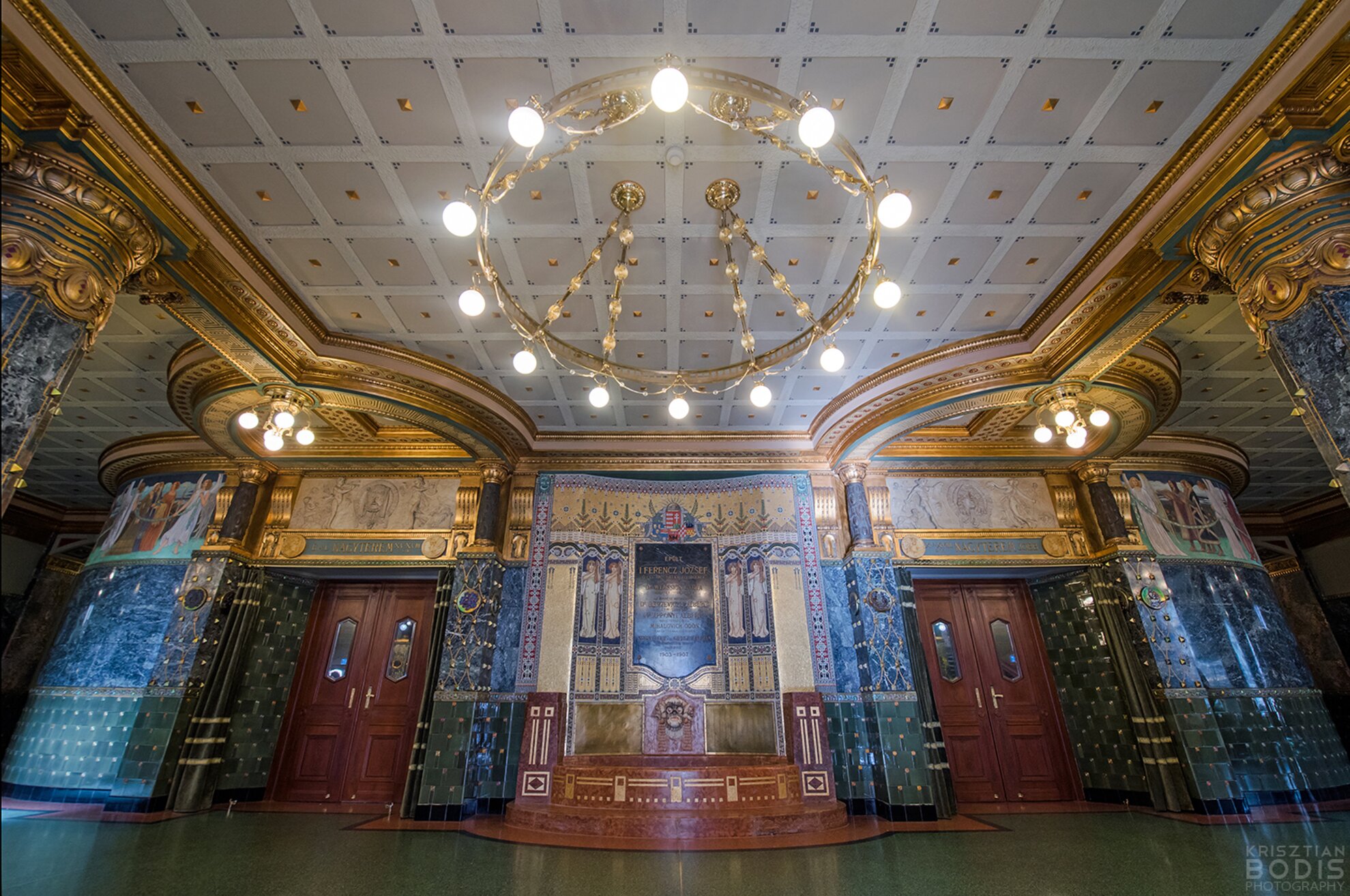Standing on downtown Budapest’s central Liszt Ferenc Square, this ornate edifice radiates prestige though its profoundly ornate walls. While this Art Nouveau building has served as the primary home to the Music Academy for 110 years now, the prodigious Hungarian pianist and composer Ferenc Liszt founded his eponymous institute back in 1875, and he actively taught (and even resided) at the school’s older Andrássy Avenue location until his passing in 1886. The newer Liszt Academy was erected in 1907, incorporating a concert hall and theater; hence, it intermingles various architectural styles. Continuing a tradition of the 19th century – when concert halls were built as shrines to the ancient-Greek god of music Apollo, and theaters were established as sanctuaries dedicated to the god of theater, Dionysus – the building’s ornaments are mostly dominated by motifs from Greek mythology, and diverse references to this duo of deities are found all around the building.


Inside, breathtakinglybeautifulfrescoes, grand chandeliers, golden inlays,Zsolnay cladding, and stained-glass windows designed by masterful Magyar applied artist Miksa Róth ornament the interior everywhere our eyes wander. The adornments all follow a “waterworld” theme; opposite from the main entrance, a well guarded by nymphs decorates the wall; a fresco in the upstairs foyer depicts “The Fountain of Art”; and other watery elements and patterns pop up elsewhere inside, such as in several majolica plates, wave-like motifs on the cornice, and in the bubble pattern of the deep-blue spheres that decorate the stairways. There are altogether 22 such spheres around the building, and legend has it that one of them hides the spirit of music inside it.


In the first-floor foyer, we find the pre-Raphaelite fresco by Hungarian artist Aladár Körösfői-Kriesch – two more of his paintings are found in the ground floor vestibule – that depicts the “Fountain of Art” enhanced with an inscription meaning: “those who wish to understand life turn to the arts”. Hence, the fresco portrays people on a pilgrimage, while above, celestial figures play auoli, the characteristic instrument of Dionysus, and angels sound the lutes of Apollo. It is interesting to note that besides some major historical figures like Alexander the Great and Dante, Hungarian revolutionary heroes such as Ferenc Rákóczi and Lajos Kossuth are also portrayed in the painting; however, they are hiding behind their gowns or in the shadow of others, as the Habsburg King of Hungary at the time, Franz Joseph, would definitely not have approved and authorized the portrayal of revolutionary figures inside such a prestigious public institute.


The principal facility of the building is the breathtakingly graceful Grand Hall, where all major concerts and performances are held. One special detail about this hall is that its three-story structure is entirely influenced by the motif of a laurel tree – which is often associated with Apollo. The tree’s black roots cover the seating area on the ground floor, its green trunks run up on the sidewalls, and its captivating golden foliage covers the ceiling. The centerpiece is taken by a splendid pipe organ in the front. Here the acoustics are extraordinary; there is not a bad seat where each distinct note cannot be heard perfectly. There is another concert hall in the Liszt Ferenc Academy as well, the Solti Hall, which is often called the “little sister” of the Grand Hall. Due to several unfortunate aesthetic and functional alterations over the past years, this hall lost its elaborate adornments, and its acoustics were also slightly deteriorated; however, it still holds a classic shoebox shape that is said to support audibility, and is often the venue of students’ final exams.



Unfortunately, the ordeals of the 20th century severely damaged this dazzling building, which was long in need of comprehensive renovations before it finally received them in 2013, when its faded glamour was restored with contemporary quality. This enabled the management to launch complete concert seasons here, so now the Academy hosts various musical programs of the highest quality, and it is one of Budapest’s premier performance centers.

The public is welcome to join multilingual guided tours of the building, but the LisztAcademy’s breathtaking splendor can also be admired by purchasing a ticket to any of the upcoming performances, when talented musicians from around the globe fill the halls with fantastic melodies. Among this spring’s highlights, music lovers can enjoy the performance of French pianist Alexandre Theraud with a Spanish swing quartet, the Cuarteto Casals, on March 11th; American violinist and conductor Joshua Bell and the Frankfurt Radio Symphony Orchestra perform on March 12th; and acclaimed South African operatic soprano Pumeza Matshikiza performs an aria recital on April 1st as part of the Budapest Spring Festival. However, visitors also have the chance to attend some performances free of charge here, as the “exam” and “diploma” concerts of the Liszt Academy’s soon-to-be-star students – such as pianists, singers, brass players, and even conductors – can often be attended by the public. Check out all of the upcoming Liszt Academy programs here.




